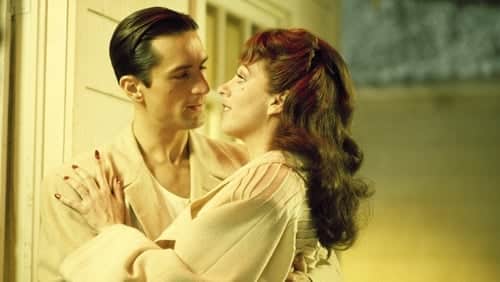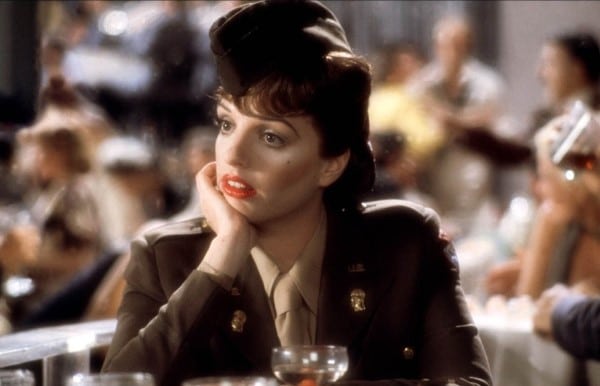A look at Martin Scorsese’s misguided musical, and the underestimation of camp.
Every month, we at The Spool select a filmmaker to explore in greater depth — their themes, their deeper concerns, how their works chart the history of cinema and the filmmaker’s own biography. This month, we’re celebrating the release of The Irishman with a retrospective on the work of Martin Scorsese. Read the rest of our coverage here.
New York, New York (1977) broke Martin Scorsese. What began as a fun experiment resulted in a flop and a cocaine habit. Had it not been for Robert De Niro’s insistence that they persevere and make a movie about a boxer, Cinema might have never had any Cathy Moriarty, or a blonde Jesus, or an “Irish” Cameron Diaz, or an Academy Award winning film featuring Gwen Stefani. Can you imagine?!
New York, New York, is an important moment in the history of the movie musical, even if it isn’t a completely successful work. It outlines a Hollywood-in-transition. Yet, for all it’s major scales, New York, New York fails to hit the note because doesn’t know how to bridge one of the studio musical’s most essential and revolutionary components: camp!
After the late 1960s, movie musicals often failed to adequately reflect changing social tastes and attitudes thus studios rarely recouped their lavish production costs. By the late 1970s, the studio system was in full rigor mortis and the musical, emblematic of studio excess and elitism, was considered by most to be a poisoned genre.
There were anomalies to this decay, of course, but for Scorsese to attempt a musical as his first Hollywood studio picture in 1977 was still a gamble. On top of that, Scorsese wanted to make a musical using New Hollywood techniques and sensibilities. He wanted to bring a new American way of filmmaking that was rooted in an honesty of form and performance, of ‘being’ rather than ‘acting’, ‘capturing’ opposed to ‘filming.’
Cabaret (1973) showed that the movie musical could touch on dark subject matter in interesting aesthetic and campy ways, yet Scorsese’s usual methodology was to strip away artifice and inject so much intensity into a genre that it bursts, revealing the seams and all they were trying to contain. After Taxi Driver (1976) Scorsese wanted to see if he could successfully juxtapose the artifice of the studio musical with the “realism” of the New Wave.
The result is a Big Band musical set immediately after WWII about a pair of creative lovers, chanteuse Francine (Liza Minnelli) and saxophonist Jimmy (Robert DeNiro), who, after 3 hours and a baby, can’t seem to find a way to be together. It is a brutally honest, totally real, gritty, in-your-face look at the troubled anger and abusive control that lurks underneath the gilded surface of the studio musical. No wonder it doesn’t work! Who wants a de-camped musical?

There are some sterling successes in New York, New York, however. Minnelli is coiffed to the heavens by Sydney Guilaroff, legendary hair stylist for Old and New Hollywood, who molded Lana Turner as a blonde, matured Judy Garland, and gave Mia Farrow her pixie cut in Rosemary’s Baby (1968). A genius. And the hats! Theadora Van Runkle’s costumes coupled with Guilaroff’s playful work give just the right amount of visual exaggeration to support Scorsese’s vision of a stylized realism.
As you’d expect, the music in Scorsese’s musical is quite good. It will definitely fill the void if you’re like me and are left incomplete by the lack of saxophone in today’s music.
Canonical broadway composers John Kander and Fred Ebb, who had written fresh material to support Liza’s Oscar-winning turn in Cabaret, reteamed with Minnelli to write her songs for the picture, including the now famous title song, which wasn’t popular until after Sinatra recorded it (though this author unsurprisingly maintains that Liza’s version is better). Through them, we get the brass we crave in “New York, New York” and the hyper-emotionality we yearn for in “And The World Goes ‘Round.”
Liza’s eyeballs are once again the leading actresses of her performance. They convey so much emotion that Scorsese’s most radical break from musical form is to shoot a shadowy close up of them. Her wide-eyed looks of terror sometimes show that she is clearly more at home with a script, but they also help Liza hold her own against De Niro’s improvisational methods. Hers is the strongest casting choice as she is a literal bridge of Old and New Hollywood, being the daughter of Judy Garland and Vincente Minnelli, whose films served inspirations for Scorsese. She was raised on old studio lots yet carries a vitality and a vibrato for a new generation.
New York, New York’s standout moment comes in the final act when Scorsese stops the film entirely and gives us a full-blown delicious MGM musical extravaganza for our nerves. Whereas the other numbers are songs Francine and Jimmy perform on stage, “Happy Endings”is in the tradition of the 21 minute ballet in An American in Paris (1953) or the “Born in a Trunk” sequence in George Cukor’s A Star is Born (1954) which don’t move the plot along but instead expresses the interiority of the character or pair of characters and simultaneously comments on film form itself through a dreamscape.
“Happy Endings” is Scorsese’s campiest moment before Cate Blanchett as Katherine Hepburn in The Aviator (2004). Scorsese gives Busby Berkeley realness with lots of dancers on a shiny soundstage. Boris Leven’s sets, which are wonderfully artificial through the whole film, are well showcased. We get high glamor fantasy, lots of feathers and a mirrored staircase. Liza serves shagadelic Judy Garland; everything is gorgeous and glistening.
To think, they cut most of this sequence out in the original theatrical release! It’s a scandal because it does serve a useful purpose. The sequence reminds us that happy endings are for the movies. It closes the wink. This is just a role Francine is playing. She doesn’t get such a happy ending. It’s everything camp should be, theatrical and critical at once.
“Happy Endings” was one of the first things Scorsese filmed. According to the DVD commentary, this was the one moment in the film he knew he wanted in the picture, so they shot it first with Vincente Minnelli on set. After that, the script started to change, in fact most of it went away in favor of unregulated improvisation. The relationship at the center got darker to be more “authentic.” While I find the ending of New York, New York to be an exciting non-traditional ending, it could have easily been achieved without De Niro’s persistent malice.
Camp does not need to be undone, it is always already willing to undress itself.
This is where the film falters. There’s nothing new about De Niro’s character. Francine is a modern woman, fresh out the army, with contemporary motivations. Jimmy is the same condescending man that shows up in a lot of classical musicals, save that his cruelty is more raw. It’s an irredeemable cruelty, which isn’t as compelling to watch as we’ve been told by the post-film school establishment. With its tale of doomed creatives who can’t be together because of the man’s insecurities. It’s as if Scorsese wanted to do A Star is Born, but was foiled when Barbra Streisand got there the year before. Her’s succeeds because feels like a natural face lift on an Old Hollywood myth.
The ending of New York, New York is exciting not because you reach a mutual and mature conclusion that this pair just won’t work, but instead because you are so relieved Francine doesn’t go back to Jimmy’s fragile ass. De Niro’s performance doesn’t succeed in commenting on or breaking open anything because his kind of abusive masculinity has remained frightfully consistent for decades, unchanged since the 1940s, 70s, or yesterday. All that’s new is De Niro is making up his insults as he goes along and is inconsistent between takes.
A terribly common trope in New Hollywood held that anger was less commercial, thus more “real,” and thus more interesting. As if yelling somehow changes film history. But violence does not inherently carry critique. It must be used properly, just like camp and it is the underestimation of camp that prevents the film from achieving it’s goals.

Camp is a way of looking at the incongruities of social organization, specifically the fluctuations of value in cultural and economic contexts. It thrives in moving between theatricality and authenticity to challenge the distinctions of both. A camp sensibility understands that artificiality does not mean superficiality, that through the unreal we might reach something equally true and perhaps better than real. Camp creates a new reality, a carnivalesque time in which social conventions can be exposed and upended. Camp does not need to be undone, it is always already willing to undress itself.
Scorsese seems to have understood only part of this. His project is one of double-looking which wants to create new reality where genres and styles can mix, which is fertile ground for camp. He knows artifice presents truths, but neglects to see that a camp wit can contain a humorous violence which reveals the concealed and allows an outsider to barb institutions.
All this was already there in the musicals Scorsese was referencing, which why New York, New York is so maddening. It’s like watching Scorsese miss an exit on the highway when you know he studied the map! But, unfortunately, New York, New York falls victim to the drives of a movement, like dear Francine in the movie. It’s a classical musical dame who gets off-roaded by the men at the steering wheel, causing premature labor. Yet, in its failings, the film gets campier as it archives the contours of two cinematic movements who just can’t seem to stay together, like the couple at its center.